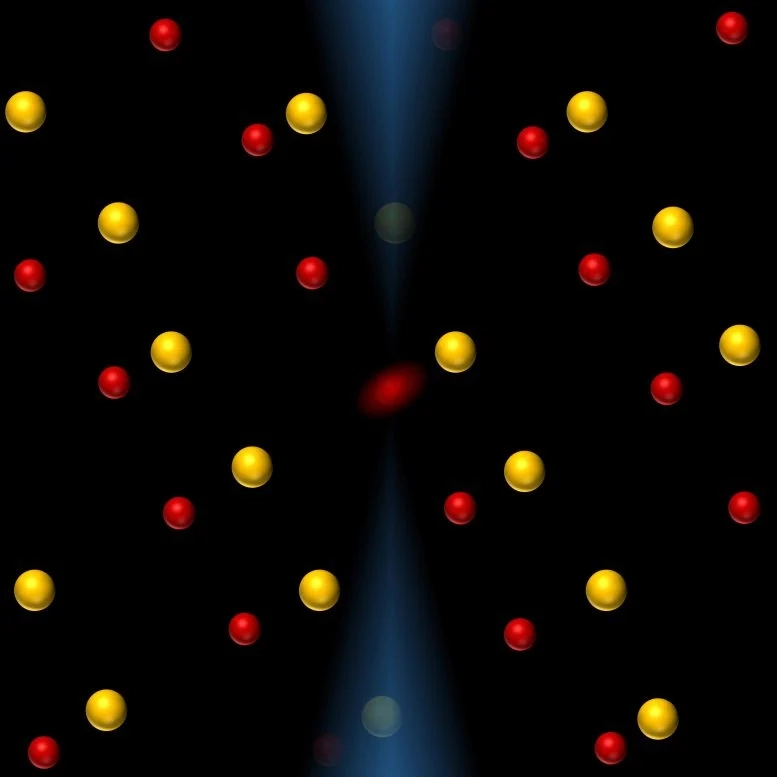 Illustration of experimental measurement of thermal vibrations in a single atom. Credit: Image courtesy Yichao Zhang et al.
Illustration of experimental measurement of thermal vibrations in a single atom. Credit: Image courtesy Yichao Zhang et al.
Scientists have imaged atomic thermal vibrations for the first time, revealing hidden patterns that could redefine quantum and nano-electronic device design.
Scientists studying atomic-level behavior in advanced electronic and quantum devices have successfully captured the first-ever microscopy images of atomic thermal vibrations. This discovery uncovers a previously unseen type of atomic motion that could play a key role in the future design of quantum technologies and extremely thin electronics.
Yichao Zhang, an assistant professor in the Department of Materials Science and Engineering at the University of Maryland, developed a new electron microscopy technique that allows researchers to directly visualize a phenomenon known as moir� phasons. These vibrations affect how heat and electricity move through two-dimensional (2D) materials, which are essential candidates for next-generation quantum and electronic applications. The research, which includes the first documented images showing the thermal vibrations of individual atoms, was published on July 24 in Science.
Two-dimensional materials are extremely thin, sheet-like structures that measure just a few nanometers in thickness. Scientists are exploring them as promising building blocks for future quantum and electronic devices. When these materials are twisted, they exhibit patterns called moir� phasons. These patterns are crucial for understanding how the materials conduct heat, behave electronically, and maintain structural integrity. Until now, moir� phasons were extremely challenging to observe in the lab, which limited scientists ability to fully grasp the potential of these materials to drive breakthroughs in quantum computing and energy-efficient technology.
Electron Ptychography: A Revolutionary Imaging Technique
Zhangs research team took on this challenge by using a new technique called electron ptychography, which achieved the highest resolution documented (better than 15 picometers) and detected blurring of individual atoms caused by thermal vibrations. Her work has revealed that spatially localized moir� phasons dominate thermal vibrations of twisted two-dimensional materials, which fundamentally reshaped how scientists understand their impact.
The breakthrough study, which confirmed the longstanding theoretical predictions of moir� phasons, also demonstrated that electron ptychography can be used to map thermal vibrations with atomic precision for the first time, which was previously an experimental capability out of reach.
This is like decoding a hidden language of atomic motion, said Zhang. Electron ptychography lets us see these subtle vibrations directly. Now we have a powerful new method to explore previously hidden physics, which will accelerate discoveries in two-dimensional quantum materials.
Zhangs research team will next focus on resolving how thermal vibrations are affected by defects and interfaces in quantum and electronic materials. Controlling the thermal vibration behavior of these materials could enable the design of novel devices with tailored thermal, electronic, and optical properties, thereby paving the way for advances in quantum computing, energy-efficient electronics, and nanoscale sensors.
Reference: Atom-by-atom imaging of moir� phasons with electron ptychography by Yichao Zhang, Ballal Ahammed, Sang Hyun Bae, Chia-Hao Lee, Jeffrey Huang, Mohammad Abir Hossain, Tawfiqur Rakib, Arend M. van der Zande, Elif Ertekin and Pinshane Y. Huang, 24 July 2025, Science.
DOI: 10.1126/science.adw7751
Never miss a breakthrough: Join the SciTechDaily newsletter.



